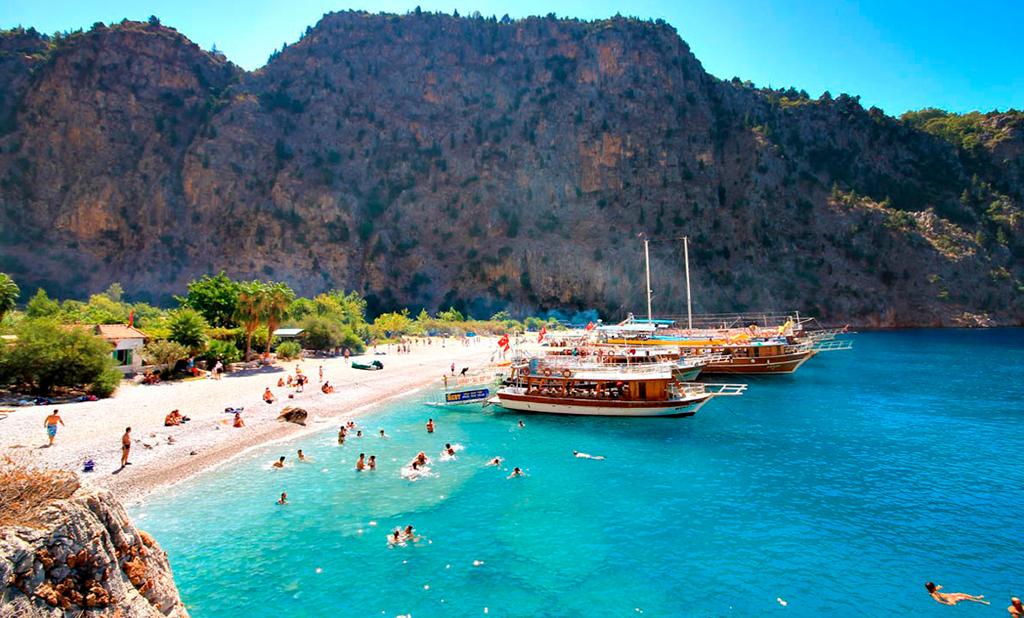Turkey
The main resorts of this country are the Mediterranean and Aegean coasts. People like the Mediterranean for the warm sea, which warms up already in May and keeps a comfortable temperature until October. Sometimes in August the water thermometer reaches a mark of +30 degrees. The Aegean coast is slightly cooler, in summer the maximum water temperature is about + 22-25 degrees, and the season usually lasts from late May to September.
Most of Turkey's beaches are pebbly, although sandy beaches are also present. For example, the resorts of the Mediterranean Sea - Alanya, Side and Belek have sand beaches. In the popular Kemer beaches are pebbly, but quite comfortable. At the same time you should be very cautious about the pebbles in the Kirishi area: here it is small and very sharp. In order to enter the sea, or just walk along the beach, you need to wear special shoes. In the area of Alanya beaches, natural slabs and rocks are often found in the water. Sometimes the deceptive sandy coast is dangerous because of the large slippery boulders covered with algae.
Beaches of the Aegean Sea are mostly pebbly. At the same time in Marmaris you can find bulk sandy beaches with a pebbly walk into the water. In Bodrum, the beaches are either stony, or are just a platform with bulk sand. By the way, in this region the sea is particularly deep, and the depth is close enough to the shore!
As for jellyfish, they usually appear in Turkey in the second half of August and September, but they do not pose any health threat.

Greece
Greece is famous for clean white or golden sandy beaches. White beaches can be found in Kos, Crete, and also on the Ionian Islands. For example, on the island of Kos there is a famous Kardamena resort with a very unusual and beautiful beach that is called Paradise Beach. Near the shore, you can observe how the bubbles of volcanic gas come out of the water.
Beaches with small or medium pebbles are located far from the main tourist places. But it is also comfortable for tourists. So, the territory of the small-rocky beach of Agios Fokas is lined with wooden paths, which are convenient to walk on.
At the same time, it is worthwhile to enter the water with care even on the checked beaches - in Greece sea urchins can often be found. Skates and needlefish, which are dug in the sand in the between-tides zone can cause trouble. As for the "uninhabited" beaches, the local bottom can sharply change from a long shoal to a sharp cliff. Jellyfish also likes the Greek coast, but the peak of their invasion usually is in September and October.

Montenegro
In Montenegro, natural sandy beaches can be found in the very south, outside Ulcinj. All the rest of the coast is either covered with rocks or large pebbles. To make it more comfortable for tourists, pebbly beaches are covered with imported sand, so basically all the equipped beaches have been turned into a mixture of sand, small and large stones. In the Boka-Kotorsky Bay because of the abrupt bank beaches consist of platforms made of concrete.
As for the temperature of the sea, from mid-June to mid-September, the water is always warm. In this case, it is worth remembering one feature of the Montenegrin sea: several times a season the water in the sea becomes extremely cold. As a rule, in 2-3 days the water warms up to the previous temperature.
It is worth noting that in the regions of Herceg Novi and Sveti Stefan the road to the beach is full of stairs and descents. For this reason, it is not recommended to go there with small children. And the city of Kotor in principle is not advised for recreation with children - it's a port and therefore the water here is quite dirty.
The Adriatic Sea is not very stormy, and there are practically no waves in the Bay of Kotor. Incidentally, this sea is considered one of the most saline, so it is ideal for those who cannot swim well or want to learn how to do that.

Croatia
Choosing the Croatian coast just while viewing the pictures, keep in mind that often the desired sand is confused with small pebbles. Indeed, the beaches of Croatia are mostly rocky and pebbly. At the resorts of Opatija, Pula, Umag, Rovinj, Porec there are many concrete slabs with stairs going down in the water. Sandy beaches can still be found on the islands of the Gulf of Kvarner - Krh, Pag, Rab and Susak. On the coast of Croatia, there are also many wild beaches, but they are dangerous beause of terrain and a lots of sea urchins.
As for sea-urchins, they are often found on tourist beaches. Therefore, to enter the water here it is recommended to wear special rubber slippers. Although, slippers will be useful for comfortable walk along the pebble beaches.
The Adriatic coast of Croatia is ideal for a holiday from mid-June to September. The sea warms up to +24 degrees, there is almost no rain, and the water is calm and transparent. For diving Saharun beach on the island of Dugi Otok is ideal. At the same time on the Paradise beach of the island of Rab, diving is not worth doing because of shallow water. In the Ning lagoon, strong warm winds are blowing, attracting fans of windsurfing.

Travel with Mydutyfree!
